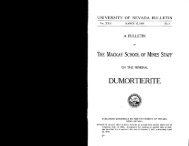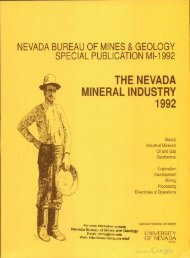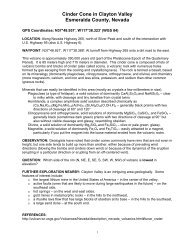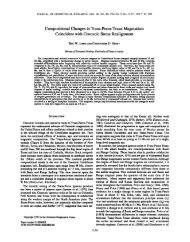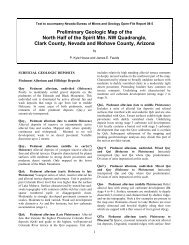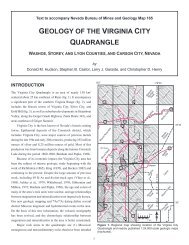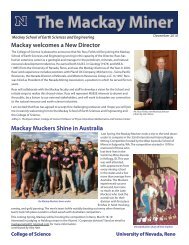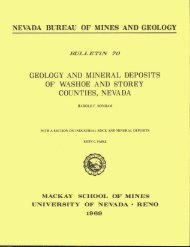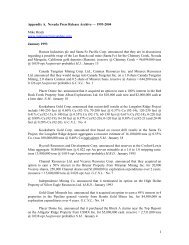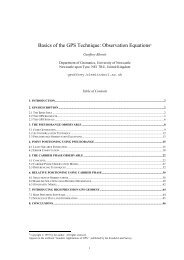Nevada Bureau of Mines and Geology - University of Nevada, Reno
Nevada Bureau of Mines and Geology - University of Nevada, Reno
Nevada Bureau of Mines and Geology - University of Nevada, Reno
You also want an ePaper? Increase the reach of your titles
YUMPU automatically turns print PDFs into web optimized ePapers that Google loves.
<strong>and</strong> the existence <strong>of</strong> a third is inferred. The oldest consists <strong>of</strong> two sets<br />
<strong>of</strong> quartz veins that contain minor amounts <strong>of</strong> gold <strong>and</strong> base metal<br />
sulphides. The youngest type is disseminated cinnabar in a shear zone that<br />
is younger than the quartz veins. Contact metamorphic rocks containing<br />
scheelite may be present in the area, but such deposits were not observed<br />
. , the only known evidence <strong>of</strong> their existence is the scheelite <strong>and</strong><br />
garnet in the placer."<br />
". . . The quartz veins occupy two northeast striking fault systems:<br />
0<br />
one, in the granodiorite stock, dips about 30 northwest <strong>and</strong> another, in<br />
the sedimentary rocks, dips steeply from northwest to southeast. The veins<br />
are generally from 3 inches to 2 feet thick, but veins as much as 8 feet<br />
thick have been observed. Some veins exposed in the mine workings give<br />
assay values in gold ranging from 0.01 to 0.05 ounces per ton <strong>and</strong> in<br />
silver ranging from 0.3 to 1.5 ounces per ton. . . . it was reported that<br />
pockets <strong>of</strong> ore running $200 in gold per 50-pound ore sack were encountered<br />
in the El Paso Mine. Galena, sphalerite, chalcopyrite, pyrite, <strong>and</strong><br />
jamesonite have been identified in some vein quartz. Small amounts <strong>of</strong><br />
scheelite were observed in two <strong>of</strong> the quartz veins, <strong>and</strong> small pebbles <strong>of</strong><br />
quartz containing scheelite have been found in the slope-wash gravels."<br />
"Cinnabar is found disseminated in a shear zone in metamorphosed<br />
shale <strong>and</strong> feldspathic quartzite <strong>of</strong> the Harmony Formation just west og the<br />
granodiorite stock. The shear zone strikes about N ~ O ~ E dips , from 20 to<br />
0<br />
35 SE <strong>and</strong> has an average width <strong>of</strong> about 5 feet over a length <strong>of</strong> 900 feet.<br />
. . . Cinnabar is disseminated throughout the shear zone <strong>and</strong> locally in<br />
the undisturbed sedimentary rocks on either side <strong>of</strong> the shear zone. . . .<br />
The average grade <strong>of</strong> the mined material was about 20 pounds <strong>of</strong> mercury per<br />
ton."<br />
"Two types <strong>of</strong> placer deposits are present in the area; stream<br />
deposits containing water-transported material, <strong>and</strong> slope-wash deposits<br />
containing material weathered from rocks in the immediate vicinity. The<br />
stream-transported material occurs in the bottoms <strong>of</strong> the larger canyons<br />
<strong>and</strong> on the alluvial fan below the mouth <strong>of</strong> Sodaris Canyon . . . The stream<br />
deposits range in depth from LO feet in the upper parts <strong>of</strong> the canyons to<br />
35 feet at the mouth <strong>of</strong> Sodaris Canyon, with an average depth <strong>of</strong> about 20<br />
feet. The depth <strong>of</strong> the alluvial fan below the mouth <strong>of</strong> the canyon is known<br />
from a few scattered prospect pits to range from 12 to 90 feet."<br />
"The slope-wash deposits are found on both sides <strong>of</strong> El Paso Gulch to<br />
a height <strong>of</strong> as much as 50 feet above the creek bottom. The slope-wash<br />
deposits, as the term is used here, include some stream-transported<br />
material which was left on the sides <strong>of</strong> the canyons as the streams cut<br />
down through bedrock. . . . The slope-wash deposits range in depth from 5<br />
to about 25 feet with an average vertical depth to bedrock <strong>of</strong> 12 feet."<br />
Current activity in the district is non-existent. There is one new<br />
block <strong>of</strong> claims staked along the range front between Sodaris <strong>and</strong> Spring<br />
Canyons. The claims were staked in February, 1985 but there (April, 1985)<br />
has been no physical work done on them.<br />
Dutch Flat DLstrict - 2



